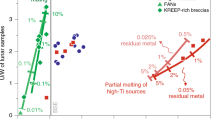Abstract
THE accretion of the Earth and Moon within the solar nebula is thought1–3 to have taken 50 to 100 million years. But the timing of formation of the Earth's core has been controversial, with some4,5 proposing that it took place within the first 15 Myr of Earth's accretion history and others6,7 proposing that it occurred after 50 Myr of accretion. Meteorite chronometry based on the 182Hf–182W system has the potential to resolve this debate, as segregation of a metal core from silicates should induce strong fractionation of hafnium from tungsten. Here we report tungsten isotope compositions for two iron meteorites, two carbonaceous chondrites, and a lunar mare basalt. We see clear 182W deficits in both iron meteorites, in agreement with previous results4,5. But the data for chondrites are inconsistent with the hypothesis of early core formation, suggesting that both this event and the formation of the Moon must have occurred at least 62 ± 10 Myr after the iron meteorites formed.
Similar content being viewed by others
References
Swindle, T. D., Caffee, M. W., Hohenberg, C. M. & Taylor, S. R. in Origin of the Moon (eds Hartmann, W. K., Phillips, R. J. & Taylor, G. J.) 331–358 (Lunar Planetary Inst., Houston, 1986).
Wetherill, G. W. in Origin of the Moon (eds Hartmann, W. K., Phillips, R. J. & Taylor, G. J.) 519–550 (Lunar Planetary Inst, Houston, 1986).
Carlson, R. W. & Lugmair, G. W. Earth planet. Sci. Lett. 90, 119–130 (1988).
Harper, C. L., Völkening, J., Heumann, K. G., Shih, C.-Y. & Wiesmann, H. Lunar planet. Sci. XXII, 515–516 (1991).
Jacobsen, S. B. & Harper, C. L. in Isotopic Studies of Crust-Mantle Evolution (eds Basu, A. R. & Hart, S. R.) (Am. Geophys. Union, in the press).
Gaier, S. J. G. & Goldstein, S. L. in Isotopic Studies of Crust-Mantle Evolution (eds Basu, A. R. & Hart, S. R.) (Am. Geophys. Union, in the press).
Allègre, C. J., Dupré, B. & Brévart, O. Phil. Trans. R. Soc. Lond. A 306, 49–59 (1982).
Käppeler, F., Beer, H. & Wisshak, K. Rep. Prog. Phys. 52, 945 (1989).
Völkening, J., Köppe, M. & Heumann, K. G. Int. J. Mass Spectrom. Ion. Proc. 107, 361–368 (1991).
Walder, A. J. & Freedman, P. A. J. analyt. atom. Spectrom. 7, 571–575 (1992).
Halliday, A. N. et al. Int. J. Mass Spectrom. Ion. Proc. 146/147, 21–33 (1995).
Lee, D.-C. & Halliday, A. N. Int. J. Mass Spectrom. Ion. Proc. 146/147, 35–46 (1995).
Yi, W., Halliday, A. N., Lee, D.-C. & Christensen, J. N. Geochim. cosmochim. Acta (in the press).
Masarik, J. & Reedy, R. C. Meteorites 29, 497–498 (1994).
Ireland, T. R. Lunar planet. Sci. XXII, 609–610 (1991).
Wasson, J. T. & Kallemeyn, G. W. Phil. Trans. R. Soc. Lond. A 325, 535–544 (1988).
Newsom, H. E. et al. Geochim. cosmochim. Acta (in the press).
Allègre, C. J., Manhès, G. & Göpel, C. Geochim. cosmochim. Acta 59, 1445–1456 (1995).
Wänke, H. Phil. Trans. R. Soc. Lond. A 303, 287–302 (1981).
Wänke, H., Dreibus, G. & Jagoutz, E. in Archean Geochemistry (eds Kroner, A., Hanson, G. N. & Goodwin, A. M.) 1–24 (Springer, New York, 1984).
Newsom, H. E. & Taylor, S. R. Nature 338, 29–34 (1989).
Newsom, H. E. & Sims, K. W. W. Science 252, 926–933 (1991).
Newsom, H. E. in Origin of the Moon (eds Hartmann, W. K., Phillips, R. J. & Taylor, G. J.) 203–229 (Lunar Planetary Inst., Houston, 1986).
Hartmann, W. K. in Origin of the Moon (eds Hartmann, W. K., Phillips, R. J. & Taylor, G. J.) 579–608 (Lunar Planetary Inst., Houston, 1986).
Cameron, A. G. W. in Origin of the Moon (eds Hartmann, W. K., Phillips, R. J. & Taylor, G. J.) 609–616 (Lunar Planetary Inst., Houston, 1986).
Ringwood, A. E. Earth planet. Sci. Lett. 111, 537–555 (1992).
Hanan, B. B. & Tilton, G. R. Earth planet. Sci. Lett. 84, 15–30 (1987).
Alibert, C., Norman, M. D. & McCulloch, M. T. Geochim. cosmochim. Acta 58, 2921–2926 (1994).
Lugmair, G. W. & Maclsaac, Ch. Lunar planet. Sci. XXVI, 879–880 (1995).
Author information
Authors and Affiliations
Rights and permissions
About this article
Cite this article
Lee, DC., Halliday, A. Hafnium–tungsten chronometry and the timing of terrestrial core formation. Nature 378, 771–774 (1995). https://doi.org/10.1038/378771a0
Received:
Accepted:
Issue Date:
DOI: https://doi.org/10.1038/378771a0
- Springer Nature Limited
This article is cited by
-
Venus Evolution Through Time: Key Science Questions, Selected Mission Concepts and Future Investigations
Space Science Reviews (2023)
-
The evolution and applications of multicollector ICPMS (MC-ICPMS)
Analytical and Bioanalytical Chemistry (2008)
-
Rayleigh-Taylor instability after giant impacts: Imperfect equilibration of the Hf-W system and its effect on the core formation age
Earth, Planets and Space (2007)





